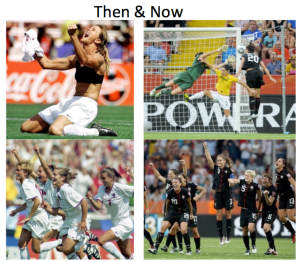… and start running them like any other team sport.
I like sports. In addition to the competition and passion, I also love the analogies that they provide. Warning, I am going to push this analogy to the limits. Get excited. Before I get started, and for my 3 followers, my opinions are based on many years of exposure to different agencies, groups, teams and client structures. Hundreds of hours spent talking and listening to gripes, successes, professional wishes and obstacles. And reading countless articles by innovative leaders, dinosaurs and wishful thinkers. Put it all together I believe I have a better approach–not a fully baked solution, but a better approach.
Now on to the sports analogies. Enter any agency in any city and odds are they are structured in one of two ways:
- Like a football team OR 2. Like a building full of decathletes
I believe that in order for any kind of success in the future (with consumers, with top talent and with top clients) agencies will need to abandon these approaches and start treating your organization like any other team sport–team being the operative word, but more on that later. First, let’s examine why the two options above are crippling agencies.
A football team (agency parallel: silos)
When a football team is broken down, the only thing that really justifies calling all of the players a singular team is the jersey they wear. Football teams are made up of silos–offense, defense, special teams and the ever popular, kickers. They have different meetings, different practices, different coaches and never really have to understand what the other silos do (and don’t make the weak point that many players that are on special teams are also part of the offensive and defensive starting line-up). Yes, they know they need each position filled, but they might as well be two separate teams each playing half of the game.
Even a head coach tends to come up through one path–an offensive on or defensive one. Trusting assistant coaches to fill in gaps, but without knowing the intricacies of every detail, coaches too can inadvertently rely on and better support what they are comfortable with
Sure, when you are winning there are all kinds of high fives and congratulations for the camera. But behind closed doors, there is jealousy. Why is the QB talking to reporters, where is my recognition? Add in losing and all hell breaks loose. The finger pointing, the public rants and the judgment. But can you really blame them?
They aren’t really one team. They don’t have a common goal (other than winning), they have no respect or accountability to the other silos, no real reason to support them when things go poorly and no true understanding for what they do–all they know is there are losing and it’s not their fault.
In the end, fans have no idea the individual importance of each position. They cheer for the franchise players and the ones getting all the attention, which usually corresponds with the most exciting or familiar. The owners sling their jerseys and bobble heads hoping that will keep seats full and tickets sold. When in reality, the team can’t win without all the silos (Colts with Manning was arguably the only exception to the rule).
Agencies can’t survive in silos of experts that don’t understand how to work as a team. That’s why continuing to run organizations like a football team will lead to disappointment. And trust me, I know football disappointment. Go Lions!
Decathletes (agency parallel: multi-tasking employees that can do it all)
On the surface, one might look at this analogy and argue the point that this is exactly what agencies need. Team members that can ‘master’ multiple disciplines, train across events and put skills together as needed. Those that argue that point would be wrong. There is a fundamental flaw with decathletes–it takes them years upon years to ‘master’ each event OR they go into the competition conceding at least one event, hoping to ‘win’ based on their strength in other events. Neither will allow you to succeed in the long-term
If it takes years of dedication in each event for a player to be the best at all of them, know that as soon as all events are mastered, some new trick comes out and they are back to training (and who has years to train employees? Especially when the rules change while you are playing). On the other hand, if decathletes go into a competition conceding the things they aren’t the best at, they won’t win in head-to-head battles. Something will suffer, something will make them lose–and in agency speak that can cost a lot (a lot of time, money and energy).
Another flaw with this argument that I’m not going to spend too much time in this section addressing is assuming that all employees want to or are capable of being decathletes.
Any other team sport.
So, where does that leave us if they two most popular agency organizational structures are set up for long-term failure? Well, I say look to any other team sport for inspiration. I will heavy up on the soccer references based on it being my favorite sport, but easily insert hockey, basketball, rugby, volleyball, lacrosse…
I’m going to borrow from something I have written before (Everything I need to know, I learned from Soccer: https://schmogel.com/2009/03/01/82462782/) to showcase how a team structure that has dedicated positions can keep passionate experts working towards shared goals.
Take a soccer team. On the field, they don’t work in silos. Sure, each team member had a specialized position–Goalie, Forward, Defense, Midfield–but they were all built upon core fundamentals. Once core fundamentals were mastered, then each specialized position learned tricks and tips dedicated their main position. And because there was a core understanding, players became good at things teammates recognized and respected–but they didn’t need to become an expert in it themselves. They did, however, know enough to be able to support and back-up when needed.
In practice we spent half the time as a full team and half the time with teammates that had the same specialized position. We talked specifically about how to do things as experts that better the team with other teammates that were just as excited and passionate about being the best in their position.
Outside of practice you did everything you could to become a better individual player–you dribbled more, you juggled, you watched tape, you lifted weights, you read strategies, you practiced shooting over and over… It is because you felt the most valuable to the team and could dedicate time to a position you were passionate about.
Trust me, there were days you didn’t want to go to practice. There were days you hated your teammates and your coach. There were days you needed support. But, despite any bad day, everyone wanted to be there, wanted to be on the team, wanted to be part of a team and wanted to win. If they didn’t, they weren’t on the team anymore.
And when the team was winning, it was because people were moving away from the ball, supporting each other–when they got back and covered. In the end, with a winning or losing record (although more fun with a winning one) you have a banquet, hand out awards, acknowledge the small and big goals, the successes and the inside jokes… you celebrated the successes and reflected on the challenges as a team.
If this analogy is applied to agency structure more overtly, I believe that like-minded experts need to have dedicated time be with others like-minded experts beyond daily responsibilities. I believe it will lead to harder workers, consistently going the extra mile because they not only believe in what they do, they honestly enjoy it. I believe that everyone should be exposed to the mindset of different experts, understand what they do and why it is valuable. I believe employees should understand how to bring together specific positions after they are comfortable understanding the role and importance of each other. I believe it is easy to figure out where individual employees excel and are passionate. I believe if there is a lack of understanding of the different experts it becomes too easy to write off what isn’t comfortable, assume it will be too difficult, become defensive, try to fake it, or worse, tell the client it’s not what they need. I believe if you ask someone to be an expert at everything they are mediocre at best.
Knowledge sharing should be celebrated, landscape and trend presentations should be discussed and mandatory, client teams should be a combination of different experts lead by coaching team (not a single person), curiosity should breed interest not skepticism. And the same amount of energy, importance, understanding and coaching should be given to each position.
I will isolate search experts to provide an example for dramatic effect due to the fact I can use hypothetical scenarios since I am indeed not a search expert. I believe search experts need dedicated time to be search nerds together. If they are separated and embedded within teams across the agency without a chance to stay experts and have permission and time to be together, the product becomes artificially watered down. In addition to being part of other teams, they need an opportunity and outlet to be with those that play their same position and are passionate about it. This holds true for Print Buyers, Digital Planners, OOH Experts, Strategists and any other position you created within your walls. If you don’t you run the following risks (or a combination of them all):
- Your best practices get bastardized and applied loosely and differently across disparate teams
- Your future bets and collective passion stall exactly where they were when the experts were broken up
- You become inefficient. There is no center of excellence. The best problems you are solving are in silo’d cases based on questions clients are asking in the now. Odds are many wheels are being reinvented
- Top-level agency positioning and application can’t practically effect or impact day-to-day needs. They become theoretical and too far removed from specific needs and/or only solve for the lowest common denominator
- Employees aren’t excited anymore; they spend too much time being expected to be an expert in something they have no interest in being an expert in. Guess what happens here… they leave and a non-expert has to step in or they stay (see number 1 and 2)
I learned very early in my soccer career… 110 yards long and 50 yards wide was way too big of an area/field for me cover by myself and it was crazy to even attempt to do a teammate’s jobs. I couldn’t play offense and defense at the same time. I couldn’t get back to my position fast enough, or with enough energy, if I felt I always had to run and help someone else in their position. Plus, it caused confusion if I was out of place. We won as a team with individual special talents because we trusted each other and knew the value each player brought to the team.
Well, there you have it, my game plan for success. Now, give it to me. Do I get to chalk up a W or start running laps?







